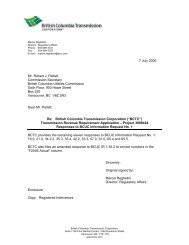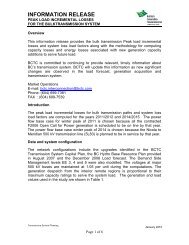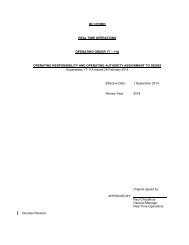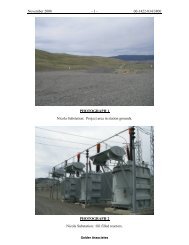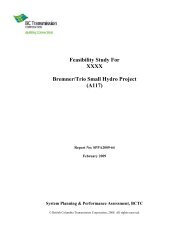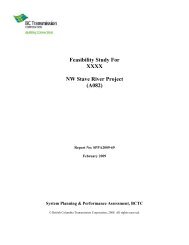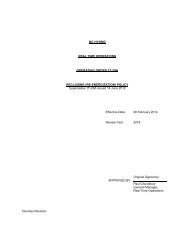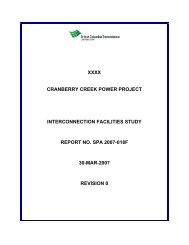Evidence on the Adequacy of First Nations Consultation - BC Hydro ...
Evidence on the Adequacy of First Nations Consultation - BC Hydro ...
Evidence on the Adequacy of First Nations Consultation - BC Hydro ...
Create successful ePaper yourself
Turn your PDF publications into a flip-book with our unique Google optimized e-Paper software.
DRAFT REPORT: Rights and Title Interests in <strong>the</strong> Columbia Valley Transmissi<strong>on</strong> Project Area<br />
established within <strong>the</strong> memory <strong>of</strong> men still living.” 183 Yet, James Teit, as reviewed below, at <strong>on</strong>e<br />
point in his investigati<strong>on</strong> reported that some believed that <strong>the</strong> Kinbasket migrati<strong>on</strong> occurred<br />
around 1810, although his own view was that “probably it was somewhat later.” 184<br />
Paul David (b. 1852), a Ktunaxa member interviewed by Claude Schaeffer in 1935, also<br />
provided informati<strong>on</strong> <strong>on</strong> <strong>the</strong> Shuswap presence in <strong>the</strong> upper Columbia. Schaeffer’s handwritten<br />
notes c<strong>on</strong>cerning this, which follow below and are emphasized as in his originals, state:<br />
The Shuswap were called kłíłkatwumłat “naked people.”<br />
See Simps<strong>on</strong>’s Journal, page 21 (1824) for Kutenai and Cree (?) raid<br />
against <strong>the</strong> Shuswap.<br />
About a century ago (1835) some akánah<strong>on</strong>ek [Tobacco Plains people]<br />
first encountered <strong>the</strong> Shuswap Indians north <strong>of</strong> Columbia Lakes, <strong>the</strong>ir<br />
first meeting (?). Prior to this <strong>the</strong> akánah<strong>on</strong>ek and Akámnik [St. Mary’s or<br />
Fort Steele people] 185 used to hunt moose and elk as far north as Golden.<br />
The Shuswap moved into this territory about <strong>the</strong> 1840s.<br />
Could <strong>the</strong>se have been <strong>the</strong> Snare people <strong>of</strong> Thomps<strong>on</strong>? 186<br />
In a typed versi<strong>on</strong> <strong>of</strong> this same informati<strong>on</strong>, dated “8/5/35” and entitled “Territory <strong>of</strong><br />
Aganahónek [Tobacco Plains people]”, Schaeffer wrote:<br />
Previous to a hundred years ago [c. 1835] <strong>the</strong> aganahónek [Tobacco<br />
Plains people] and gakawakamitúkinik [Michel Prairie people] used to<br />
hunt toge<strong>the</strong>r north <strong>of</strong> Columbia Lakes, probably as far as Golden, for<br />
moose and elk. 187<br />
Ktunaxa member Louis Joseph provided Schaeffer with additi<strong>on</strong>al informati<strong>on</strong> <strong>on</strong> <strong>the</strong> Ktunaxa<br />
perspective. Louis Joseph’s oral traditi<strong>on</strong> is somewhat c<strong>on</strong>sistent with <strong>the</strong> Shuswap traditi<strong>on</strong>s<br />
183 Tolmie and Daws<strong>on</strong> 1884, page 125.<br />
184 James Teit (1908-1920). Salish ethnographic materials. American Philosophical Society Library,<br />
Philadelphia. Boas Collecti<strong>on</strong> 372, Roll 16, S .7 (copy held by <strong>the</strong> B.C. Archives, Victoria. Add. Mss. 1425,<br />
Micr<strong>of</strong>ilm A-247).<br />
185 Elsewhere in his fieldnotes, including <strong>the</strong> typed variant cited below, Schaeffer wrote that it was <strong>the</strong><br />
Michel Prairie people—not <strong>the</strong> St. Mary’s people—who in former times hunted toge<strong>the</strong>r with <strong>the</strong> Tobacco Plains<br />
people, north <strong>of</strong> Columbia Lakes.<br />
186 Schaeffer 1934-1969, Reel 1.<br />
187 Schaeffer 1934-1969, Reel 2.<br />
Bouchard & Kennedy Research C<strong>on</strong>sultants Page 43<br />
Page 46 <strong>of</strong> 200






